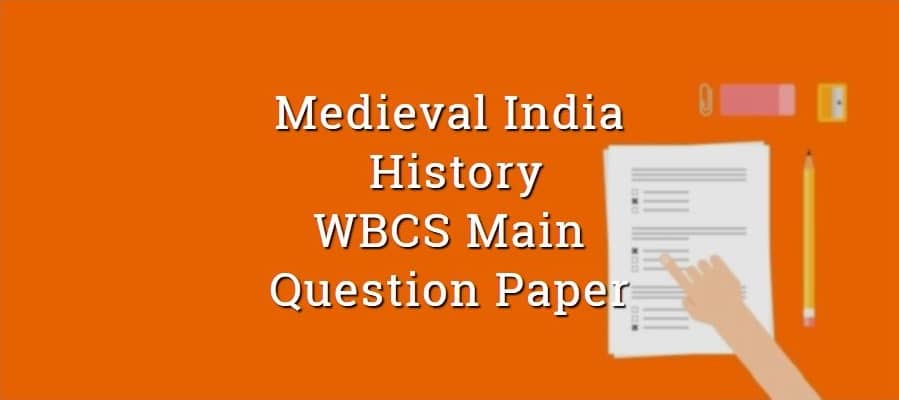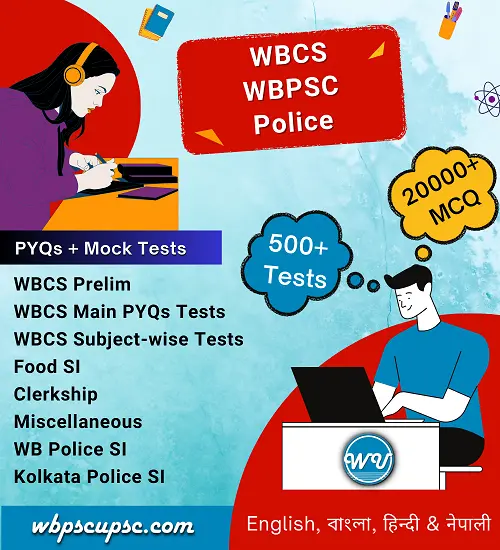Medieval Indian History – WBCS Main Question Paper
Contents

medieval indian history questions
WBCS Main Question Paper – 2023
7. Who was the Last ruler of the Delhi Sultanate?
(A) Daulat Khan Lodi
(B) Ibrahim Lodi
(C) Alam Khan Lodi
(D) Jahandar Lodi
11. Who reformed the revenue system during the rule of Akbar?
(A) Raja Maan Singh
(B) Birbal
(C) Todarmal
(D) Jai Singh
13. First battle of Panipat took place in
(A) 1526
(B) 1528
(C) 1616
(D) 1626
17. ‘Akbarnama‘ was composed by
(A) Mughal Emperor Akbar
(B) Abul Fazl
(C) Faizi
(D) Bairam Khan
19. Ibadatkhana was founded by
(A) Akbar
(B) Jahangir
(C) Shah Jahan
(D) Aurangzeb
28. Treaty of Purandar (1665) was concluded between
(A) Shivaji and Jai Singh
(B) Tipu Sultan and English East India Company
(C) English East India Company and Ranjit Singh
(D) English East India Company and the Marathas
32. Who won the first battle of Tarain?
(A) Prithviraj Chauhan
(B) Muhammad Ghori
(C) Muhammad-bin-Qasim
(D) Sultan Mahmud of Ghazni
39. Who was the author of the book ‘Muntakhab–ul–Tawarikh‘?
(A) Nizam-ud-din
(B) Amir Khusrau
(C) Faizi
(D) Badauni
40. Who composed ‘Rajatarangini‘?
(A) Kalhana
(B) Bilhana
(C) Banabhatta
(D) Ashvaghosha
41. Who composed ‘Khaza’in-ul-Futooh‘?
(A) Amir Khusrau
(B) Hasan Nizami
(C) Khafi Khan
(D) Abdal-Qadir Badauni
48. Who introduced ‘Kabuliyat’ and ‘Patta’?
(A) Shivaji
(B) Ashoka
(C) Sher Shah
(D) Akbar
59. ‘Mandalam’ and ‘Nadu’ these two institutions were associated with
(A) the Pallavas
(B) the Cholas
(C) the Pandyas
(D) the Rashtrakutas
63. In which year Vasco-da-Gama arrived in Kalikat?
(A) 1757
(B) 1498
(C) 1497
(D) 1598
64. Who was the general and successor of Muhammad Ghori?
(A) Muhammad-ibn-Bakhtyar
(B) Qutub-ud-din Aibak
(C) Tajuddin Yaldiz
(D) Nasiruddin
65. Who invaded South India?
(A) Balban
(B) Iltutmish
(C) Qutub-ud-din Aibak
(D) Alauddin Khilji
66. Who composed the book of ‘Tahqiq-i-Hind‘?
(A) Al Beruni
(B) Al Masudi
(C) Khafi Khan
(D) Hasan Nizami
68. Jiziya was reimposed by
(A) Aurangzeb
(B) Shah Jahan
(C) Jahangir
(D) Bahadur Shah
74. The Yusufzai revolt took place during the reign of
(A) Shahjahan
(B) Akbar
(C) Aurangzeb
(D) Jahangir
76. During the Arab invasion in 712 AD the ruler of Sindh was defeated by whom ?
(A) Sultan Mahmud of Ghazni
(B) Muhammad Ghori
(C) Muhammad-bin-Qasim
(D) Tajuddin Yildiz
79. Who composed the ‘Vikramankadevacharita‘?
(A) Bilhana
(B) Ravikirti
(C) Banabhatta
(D) Kalhana
83. Which Mughal ruler took the title of Alamgir?
(A) Akbar
(B) Jahangir
(C) Shah Jahan
(D) Aurangzeb
87. Which Mughal ruler granted Diwani Rights of Bengal to the English East India Company?
(A) Farrukhsiyar
(B) Bahadur Shah Zafar
(C) Jahandar Shah
(D) Shah Alam II
88. Who came to Jahangir’s Court?
(A) Sir Thomas Roe
(B) Ibn Battuta
(C) Nuniz
(D) Domingo Paes
93. Who was known as ‘Parrot of India‘?
(A) Tansen
(B) Surdas
(C) Amir Khusrau
(D) Abul Fazl
98. Who was a famous artist of Akbar’s Court?
(A) Basawan
(B) Bebadal Khan
(C) Ravi Verma
(D) Minhaj-us-Siraj
99. The duration of Tripartite Struggle was
(A) 200 years
(B) 100 years
(C) 400 years
(D) 50 years
WBCS Main Question Paper – 2022
3. Akbar was born at
(A) Pathankot
(B) Sialkot
(C) Amarkot
(D) Nagarkot
4. The autobiography of Babur was known as
(A) Chach Namah
(B) Firdaus Namah
(C) Babur Namah
(D) Shah Namah
8. The court customs of Sijda and Poibos were introduced by
(A) Qutubuddin Aibak
(B) Alauddin Khilji
(C) Ghiyasuddin Balban
(D) Ibrahim Lodi
18. The First Battle of Tarain took place in
(A) 1191 AD
(B) 1176 AD
(C) 1105 AD
(D) 1155 AD
21. Delhi Sultanate was established in India in
(A) 1205 AD
(B) 1215 AD
(C) 1206 AD
(D) 1207 AD
24. The Sadak-i-Azam was constructed by
(A) Akbar
(B) Bahadur Shah
(C) Babur
(D) Sher Shah
26. Abdul Hamid Lahori was the author of
(A) Padshahnama
(B) Razm Namah
(C) Iqbal Namah
(D) Tabaqat
30. The Qadri order of Sufis was founded by
(A) Shah Niamatullah Qadri
(B) Baba Farid
(C) Bakhtiyar Kaki
(D) Shah Jalal
31. The “Boro Sona Masjid” in Bengal was built by
(A) Alauddin Hussein Shah
(B) Nusrat Shah
(C) Shah Shuja
(D) Shah Jahan
33. The “Alai Darwaza” was constructed by
(A) Alauddin Khilji
(B) Muhammad Bin Tughlaq
(C) Sikander Lodi
(D) Ibrahim Lodi
36. Who was known as the “Akbar of Kashmir”?
(A) Sikander Shah
(B) Zain ul Abedin
(C) Akbar
(D) Muhammad Shah
40. The capital from Delhi to Daulatabad was shifted by
(A) Alauddin Khilji
(B) Bakhtiyar Khilji
(C) Muhammad Bin Tughlaq
(D) Akbar
41. The Vijaynagar State was founded by
(A) Harihara and Bukka
(B) Chenna and Pedanna
(C) Tiruvalluvar
(D) Malik Ambar
42. The following is a Sufi order:
(A) Namdhari
(B) Kirpandhari
(C) Auliya
(D) None of the above
44. The market control regulations were introduced by
(A) Alauddin Khilji
(B) Balban
(C) Babur
(D) Sikander Lodi
46. Sufi orders were generally known as
(A) Siayasa
(B) Virasat
(C) Hukumat
(D) Silsilah
47. Abul Fazl was the court poet of
(A) Babur
(B) Akbar
(C) Shah Jahan
(D) Jahangir
52. Sir Thomas Roe had visited the court of
(A) Akbar
(B) Shah Jahan
(C) Jahangir
(D) Babur
59. Who was known as “Lakh Baksh”?
(A) Balban
(B) Qutubuddin Aibak
(C) Bahlol Lodi
(D) Ibrahim Lodi
61. The Arab conquest of Sindh is depicted in
(A) Akbar Namah
(B) Ain i Akbari
(C) Chach Namah
(D) Shah Namah
64. The “Tarikh i Firuz Shahi” was the work of
(A) Abdul Khader Badauni
(B) Ziauddin Barani
(C) Bhimsen Burhanpuri
(D) Tansen
66. The First Battle of Panipat took place in
(A) 1520
(B) 1530
(C) 1525
(D) 1526
74. Zabti was
(A) Currency
(B) Trade
(C) Customs
(D) Land Revenue System
76. Shah Jahan had built the Taj Mahal in memory of
(A) Arjumand Banu Begum
(B) Anarkali
(C) Jahanara
(D) Rowshanara
77. The land revenue system under Akbar was systematized by
(A) Raja Beharimal
(B) Raja Todarmal
(C) Raja Chunnumal
(D) Birbal
78. The firman of 1717 was issued by
(A) Farrukhsiyar
(B) Jahangir
(C) Aurangzeb
(D) Jahandar Shah
79. The book written by Ibn Batuta was
(A) Saleha
(B) Rehala
(C) Kitab ul Ibar
(D) Razm Namah
82. The original name of Nurjahan was
(A) Luftunnissa
(B) Khairunnisa
(C) Meherunnisa
(D) Raziya
85. Who was afflicted by the “Deccan Ulcer”?
(A) Akbar
(B) Babur
(C) Aurangzeb
(D) None of the above
86. The first woman ruler of the Delhi Sultanate was
(A) Rabeya
(B) Rokeya
(C) Razia
(D) Zubeida
89. Akbar defeated Hemu in the
(A) First Battle of Panipat
(B) Third Battle of Panipat
(C) Second Battle of Panipat
(D) Battle of Haldighati
93. Mukundaram was the author of
(A) Padma Puran
(B) Barsha Mongal
(C) Chandi Mongal
(D) None of the above
99. Tabaqat i Nasiri was written by
(A) Sirajuddin
(B) Minhaj us Siraj
(C) Khafi Khan
(D) Firuz Tughlaq
WBCS Main Question Paper – 2021
36. Which was the earliest seat of Turkish power in Delhi?
(1052 – 1060 )
(A) Qila-i Rai Pithora
(B) Koshak-i Siri
(C) Purana Qila
(D) Jahanpanah
69. How were foreign merchants referred to in Chola documents?
(A) Manigramam
(B) Nanadeshi
(C) Ayyavole
(D) Pattinam
110. What occasioned the break between the Mughals and the Rajputs?
(A) Increasing importance of the Marathas in Mughal state.
(B) Succession crisis in Marwar after the death of Jaswant Singh.
(C) Aurungzeb’s favoritism towards Muslims in Mughal service.
(D) Aurungzeb’s demolition of Hindu temples.
124. Who was the author of the Prabandha Chintamani?
(1304, Gujarat)
(A) Medhatithi
(B) Merutunga
(C) Shriharsha
(D) Soddhala
145. Who was the author of Rajatarangini?
(A) Kalhana
(B) Jonaraja
(C) Srivara
(D) All of the above
172. Which of the following is true of the Mansabdari system?
(i) Mansab denotes the rank an official held in the Mughal hierarchy.
(ii) Mansabdari usually entailed military obligation towards the empire.
(iii) Salary of a Mansabdar was indicated in the sawar rank he held.
(iv) Remuneration for Mansabdari was provided only in terms of grants of jagir.
(A) (i), (iii), (iv)
(B) (i), (ii), (iv)
(C) (i), (ii)
(D) (i), (ii), (iii), (iv)
WBCS Main Question Paper – 2020
8. Who is the only woman historian to write a historical account of the Mughal period?
(Humayun-Nama)
(A) Gulbadan Begum
(B) Noorjahan
(C) Jahanara Begum
(D) Zebun-nissa Begum
10. Which of the following facts about the Taj Mahal is incorrect?
(Built – 1632–53)
(A) It is a magnificent Mausoleum
(B) It was built by Shah Jahan
(C) It is situated outside the Agra Fort
(D) The names of artisans who built are engraved on it
12. The Persian ruler who besieged Qandahar in Jahangir’s reign was
(1622)
(A) Shah Muhammad
(B) Shah Parvez
(C) Shah Abbas
(D) Shah Raza
19. The popular name of Muizuddin Muhammad Bin Sam was
(1149 – 1206)
(A) Sultan Mahmud
(B) Muhammad Ghori
(C) Timur
(D) None of the above
20. Kamban’s Ramayana in Tamil was written during the reign of
(12th century)
(A) Chalukya
(B) Pallavas
(C) Cholas
(D) Kakatiyas
21. Who constructed the ‘Grand Trunk Road‘?
(A) Akbar
(B) Sher Shah Suri
(C) Ashoka
(D) Samudra Gupta
22. Silver ‘Tanka’ and Copper ‘Jital’ were introduced by
(A) Qutubuddin Aibek
(B) Raziya Sultana
(C) Iltutmish
(D) Balban
25. Who faced defeat in the Battle of Chandawar in 1194 AD?
(A) Bhima II
(B) Jaichand
(C) Lakshman Sena
(D) Muhammad Ghori
26. The founder of the Lodi dynasty was
(1451-1526)
(A) Bahlul Lodi
(B) Sikandar Lodi
(C) Ibrahim Lodi
(D) Daulat Khan Lodi
33. The name of Sultan Mahmud’s father is
(971 – 1030)
(A) Alptigin
(B) Sabuktigin
(C) Ulugh Khan
(D) Nove of the above
34. Who of the following became a member of the Din-i-Ilahi?
(A) Todar Mal
(B) Raja Birbal
(C) Raja Man Singh
(D) Tansen
37. Who was the Hindu king at the time of Muhammad bin Qasim’s invasion of Sind?
(Battole of Aror, 712)
(A) Dahir
(B) Hala
(C) Harsha
(D) Ananda Pala
38. Ghazi Malik was the actual name of
(A) Ghiyas uddin Tughlaq
(B) Muhammad bin Tughlaq
(C) Firuz Shah Tughlaq
(D) None of the above
44. The Persian poet Firdausi who composed ‘Shah Namah’ was associated with the court of
(977 – 1010 CE)
(A) Sultan Mahmud
(B) Muhammad Ghori
(C) Shah Tahmasp
(D) None of the above
46. Two major crops introduced in India during the Mughal period were
(A) Millet and Groundnut
(B) Potato and Mustard
(C) Tobacco and Maize
(D) Indigo and Maize
48. The Somnath Temple of Gujarat was destroyed by Sultan Mahmud in
(A) 1015 AD
(B) 1020 AD
(C) 1025 AD
(D) 1027 AD
50. The Dilwara Temples at Mount Abu were constructed during the rule of
(Vimal Shah, 1031)
(A) Chalukyas
(B) Solankis
(C) Kalachuris
(D) None of the above
52. The Russian merchant traveller Nikitin visited South India in
(A) 14th Century
(B) 15th Century
(C) 16th Century
(D) None of the above
54. Which of the following systems were the backbones of the Vijaynagar administration?
(A) Nitinirdesha and Dandniti
(B) Karyapalika and Nayankara
(C) Nayankara and Ayagar
(D) Dandniti and Spy system
57. ‘Diwan-i-Khairat‘, a Ministry of Charity was organised by
(A) Alauddin
(B) Ghiyas uddin
(C) Firuz Shah
(D) None of the above
59. The Mughals imported fruits from
(Uzbekistan)
(A) Samarkand
(B) Arabia
(C) Kabul
(D) Portugal
63. Which Mughal Emperor transferred the capital from Agra to Delhi?
(1638)
(A) Jahangir
(B) Shah Jahan
(C) Aurangzeb
(D) Bahadur Shah
67. Which of the following works refer to the History of Sind and it’s conquest by the Muslim?
(A) Taj-ul-Manthir
(B) Chach Namah
(C) Lubab-ul-Abab
(D) Kitab-i-Tahqiq
69. Who was the author of ‘Tabaqat-i-Nasiri‘?
(1260)
(A) Ibn Batura
(B) Minhaj-us-Siraj
(C) Isami
(D) Ziauddin Barani
74. Jizya was abolished by the Mughal ruler
(1564)
(A) Babur
(B) Humayun
(C) Akbar
(D) Aurangzeb
78. King Jaypala, who faced Sultan Mahmud’s invasion belonged to the
(964 to 1001 CE)
(A) Chalukya dynasty
(B) Hindu Shahi dynasty
(C) Pandya dynasty
(D) None of the above
80. The Mughal Prince who was well versed in Arabic, Persian and Sanskrit was
(A) Prince Akbar
(B) Prince Salim
(C) Prince Sulaiman Shukoh
(D) Prince Dara Shikoh
87. Aurangzeb sent Mukarrab Khan against
(A) Shahji Bhonsle
(B) Shivaji
(C) Sambhaji
(D) Shahu
93. Ramachandra Yadav, who faced Alauddin’s invasion was the ruler of
(1296, Maharashtra)
(A) Devagiri
(B) Malwa
(C) Ujjain
(D) Telangana
94. Which Mughal Emperor was a patron of Hindustani music and was popularly known as Rangila?
(A) Bahadur Shah I
(B) Bahadur Shah II
(C) Muhammad Shah
(D) Ahmed Shah
95. Sant Jnaneshwar was the author of
(Marathi language)
(A) Amrutanubhav
(B) Rukmini Swayamvar
(C) Dasbodha
(D) Vivek sindhu


